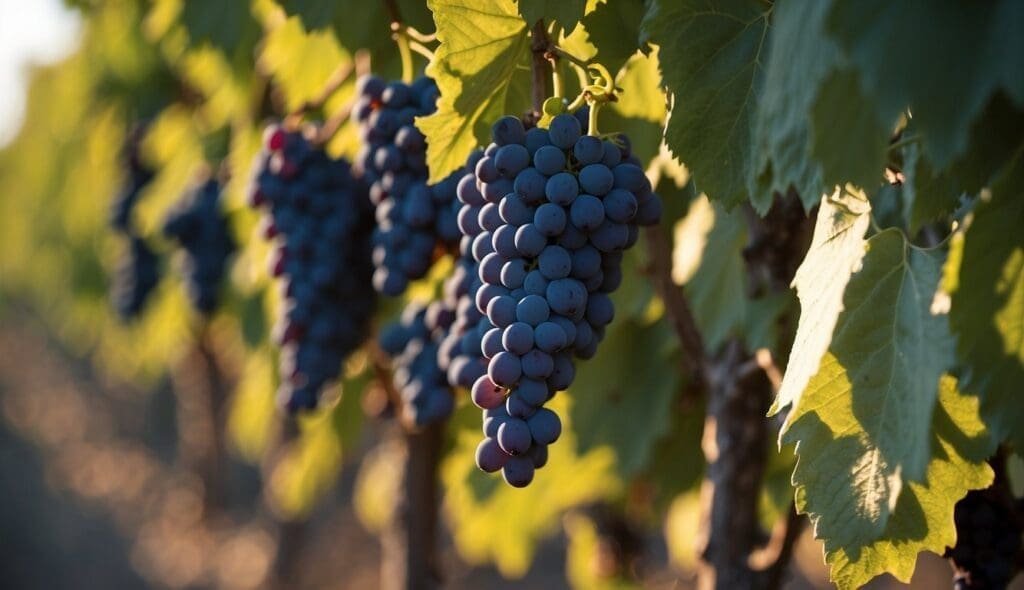This post may contain affiliate links. Please read my disclosure policy.
Ever wondered what’s the difference between Pinot Gris and Pinot Grigio? While they might sound like two completely separate wines, they’re actually made from the same grape variety. The key difference lies in their country of origin and winemaking styles.
Pinot Gris, commonly found in France, is known for its rich, aromatic profile with hints of spice. On the other hand, Pinot Grigio, most popular in Italy, tends to be light, crisp, and less aromatic. Discovering which you prefer might open up a new favourite white wine for your collection.
In Australia, producers use these names to signal different styles. For a bright and refreshing experience, look for Pinot Grigio. If you’re after something more complex and textured, give Pinot Gris a try. With this knowledge, you can easily navigate your next visit to the wine aisle.
Difference between Pinot Gris and Pinot Grigio
Pinot Gris and Pinot Grigio share a common ancestry but have developed distinct identities due to their unique origins and genetic variations. Understanding these differences can deepen your appreciation for these wines.
Genetic Mutation and Relation to Pinot Noir
Pinot Gris, also known as Pinot Grigio, is a genetic mutation of Pinot Noir. This mutation causes a change in the grape skin from dark blue or black (Pinot Noir) to a greyish-blue hue, creating the white grape varieties you now recognize.
The relationship between these grapes explains some similarities in flavor and texture. Despite being a white grape, Pinot Gris retains some characteristics of its red counterpart, making it unique among white wines.
Regional History in France and Italy
Pinot Gris has its roots in the Burgundy region of France, where it was likely first cultivated as a mutation from Pinot Noir. French winemakers, especially in the Alsace region, have embraced this grape, transforming it into richly flavoured wines with notes of stone fruits and spice.
In Italy, Pinot Grigio flourishes in the north-eastern regions. Italian winemakers often pick the grapes earlier, resulting in a crisper and more acidic wine compared to its French counterpart. This difference in harvesting and production has helped Pinot Grigio carve out a distinct identity.
For a taste of Australian varietals, try wines from Tasmania or the Yarra Valley, regions known for their cool climates and excellent Pinot Gris and Pinot Grigio.
Viticulture and Winemaking Practices

Pinot Gris and Pinot Grigio wines can vary greatly due to differences in vineyard terroir, climate, and winemaking techniques. Each factor plays a crucial role in shaping the final product.
Vineyard Terroir and Climate Impact
Pinot Gris and Pinot Grigio grapes thrive in diverse environments. For instance, the terroir of Alsace in France contributes to richer, riper Pinot Gris, while Italy’s Alto Adige region produces lighter, crisper Pinot Grigio. Cooler climates, like those in Germany and Oregon, enhance the grape’s acidity and freshness. In Australia, Pinot Gris from regions such as the Adelaide Hills can offer a balance of fruitiness and minerality.
The climate impacts grape ripeness and sweetness. Pinot Gris from Alsace, occasionally picked later for the Vendages Tardives style, can be sweet with honeyed notes. Conversely, Pinot Grigio from northern Italy often has a zesty, refreshing quality due to earlier harvests. Both styles benefit from the unique characteristics of their growing regions.
Winemaker’s Influence on Style
Winemaking techniques further define the differences between Pinot Gris and Pinot Grigio. In Alsace, winemakers may age Pinot Gris in oak barrels, adding complexity and a silkier texture. Australian varietals often embrace these methods, resulting in richer profiles. By contrast, Italian style Pinot Grigio is typically stainless steel-fermented, preserving its bright, fruity character.
The winemaker’s choices, from harvest timing to fermentation practices, significantly influence the wine’s final style. American Pinot Grigio, for example, can range from light and crisp to slightly fuller-bodied, depending on the region and producer. Similarly, in regions like New Zealand, innovative techniques lead to distinct and varied expressions of this versatile grape.
These practices, tailored to each variety, ensure a diverse and enjoyable range of Pinot Gris and Pinot Grigio wines.
Sensory Profile and Tasting Notes

Pinot Gris and Pinot Grigio each offer distinct sensory experiences. These differences stem from their unique winemaking styles and regional influences, particularly in their aroma, flavour profile, texture, and body.
Aromatics and Flavour Palette
Pinot Gris often boasts richer, fuller aromas and flavours. Common notes include stone fruits like apricot and peach, with occasional hints of honey and spice. This wine may also have floral aromas of honeysuckle.
In contrast, Pinot Grigio is typically crisper and more refreshing. Expect citrus notes such as lemon and lime, along with green apple and pear. This variety may also present a light minerality.
If you compare a Pinot Gris from Alsace, France to a Pinot Grigio from Friuli, Italy, you will notice these regional characteristics sharply: the former being richer and sweeter versus the latter’s dry, zesty profile.
Texture and Body Comparison
Pinot Gris is generally full-bodied, with a smooth, almost creamy texture. This gives it a plump, fleshy feel, making it richer compared to its counterpart. Alsace Pinot Gris, for instance, exemplifies this with its unctuous texture.
On the contrary, Pinot Grigio tends to be light-bodied, offering a crisp, clean texture. It is more acidic, which enhances its refreshing nature. The Pinot Grigios from Northeast Italy, specifically Friuli, are known for this zesty, racy style.
When tasting Australian Pinot Grigio, you will often find the bright acidity and crisp finish typical of the variety. For Australian Pinot Gris, expect fuller-bodied wines with a richer mouthfeel.
Food Pairing and Serving Suggestions

Pinot Gris and Pinot Grigio each have unique flavours that pair beautifully with various dishes. Understanding how these wines complement specific foods can enhance your dining experience.
Ideal Culinary Combinations
Pinot Gris from Alsace is richer and more complex. It pairs well with hearty dishes like pork and rich seafood such as lobster. The wine’s full body and notes of apricot, honey, and spice make it a great companion to recipes that include ginger or cinnamon.
Italian Pinot Grigio, on the other hand, is lighter and more acidic. It’s well-suited for sushi, salads, and grilled fish. The crispness of Pinot Grigio enhances the fresh flavours of these dishes. You can also enjoy it with turmeric or saffron-infused recipes for an interesting flavour balance.
Food Pairing Summary:
- Pinot Gris: Pork, lobster, ginger, cinnamon
- Pinot Grigio: Sushi, salads, grilled fish, turmeric, saffron
Optimal Serving Temperature
The serving temperature for Pinot Gris and Pinot Grigio can impact their taste. Alsace Pinot Gris should be served a bit warmer at around 12-14°C. This temperature allows its complex flavours, such as apricot and honey, to shine.
Italian Pinot Grigio is best enjoyed when it’s slightly cooler, between 8-10°C. The cooler temperature highlights its crisp, refreshing characteristics, making it perfect for hot weather or light meals.
Serving Temperature Guidelines:
- Pinot Gris: 12-14°C
- Pinot Grigio: 8-10°C
By serving these wines at their ideal temperatures, you can fully appreciate their unique profiles and enhance your food pairing experiences.
Frequently Asked Questions
These questions cover key aspects of Pinot Gris and Pinot Grigio, such as their taste profiles, body, sweetness, and differences from other wines like Sauvignon Blanc.
What characterises the taste profile of Pinot Gris compared to Pinot Grigio?
Pinot Gris tends to have a richer, fuller taste with hints of spice and fruit. It’s often described as lush and aromatic. On the other hand, Pinot Grigio is more zesty and light, with bright acidity and clean savoury notes typical of north-eastern Italy vineyards.
Can Pinot Gris be described as a full-bodied wine?
Yes, Pinot Gris is often described as full-bodied. Its grapes are picked later, which helps in developing a richer and plumper profile. This makes it a popular choice for more robust dishes.
In terms of sweetness, how do Pinot Grigio and Pinot Gris differ?
Pinot Grigio is typically less sweet due to its higher acidity. While most Pinot Grigio wines are dry, some cheaper varieties can be a bit sweet. Conversely, Pinot Gris can have a slight sweetness, especially those from regions like Alsace.
What are the primary differences in flavour between Pinot Grigio and Sauvignon Blanc?
Pinot Grigio usually has a light, crisp flavour with notes of lemon and green apple. Sauvignon Blanc is more aromatic with grassy and herbaceous notes and often more pronounced acidity. While both are white wines, their flavour profiles are quite distinct.
Is the wine variety Pinot Grigio typically considered red or white?
Pinot Grigio is a white wine. Despite the greyish-blue colour of the grape skin, the wine produced is white. It is renowned for its light, refreshing qualities.
Why is Pinot Gris often regarded as a superior wine choice?
Pinot Gris, especially from regions like Alsace, is lauded for its complexity and depth. Its fuller body and rich flavours often make it a favourite for those pairing wine with diverse dishes. The winemaker’s ability to achieve these characteristics is a testament to its superior quality.
User Review
( votes)Sip smarter, subscribe now!
Subscribe for gourmet tips, event updates, travel ideas, and a free e-book on Food Pairings. Start your journey to culinary and travel excellence!













